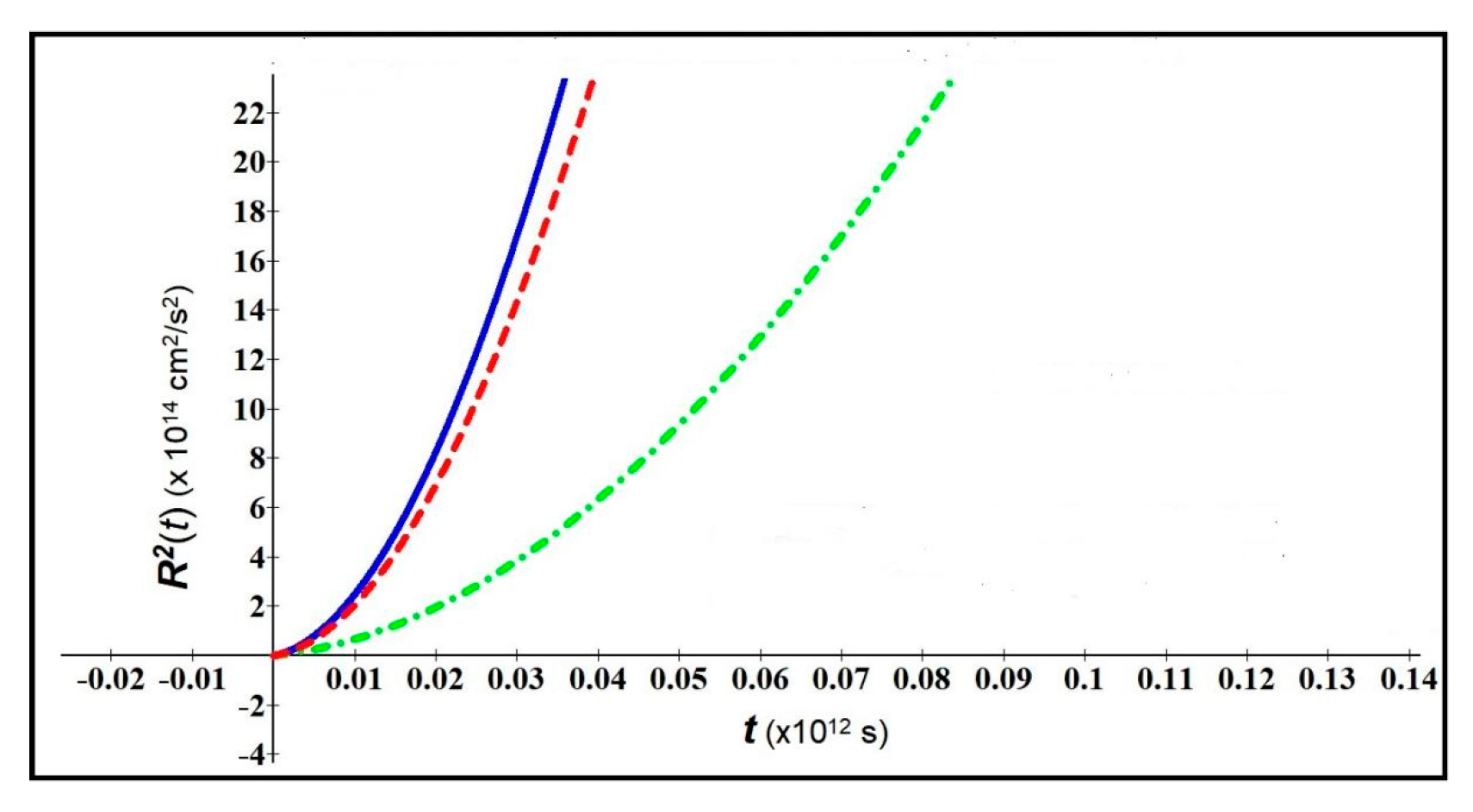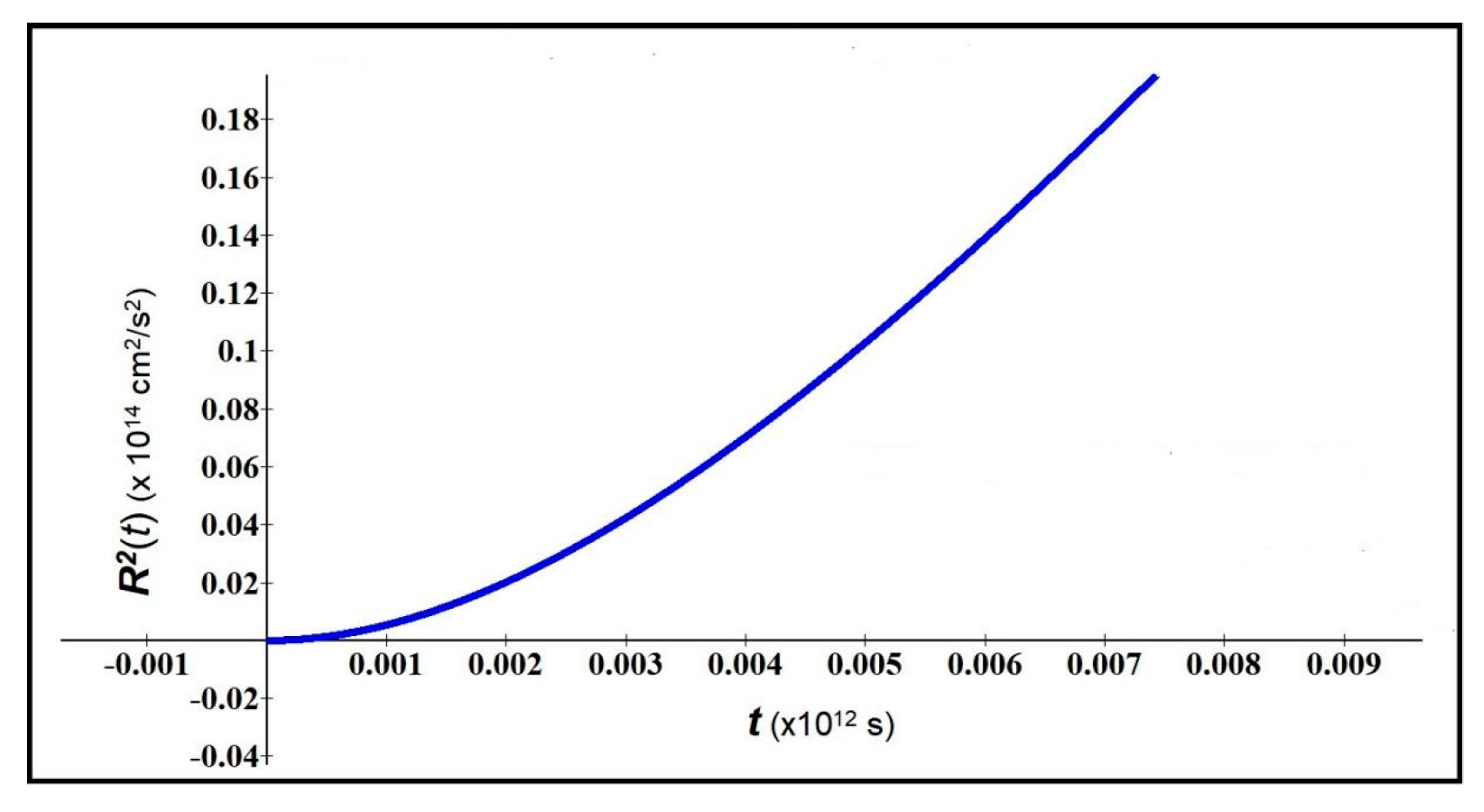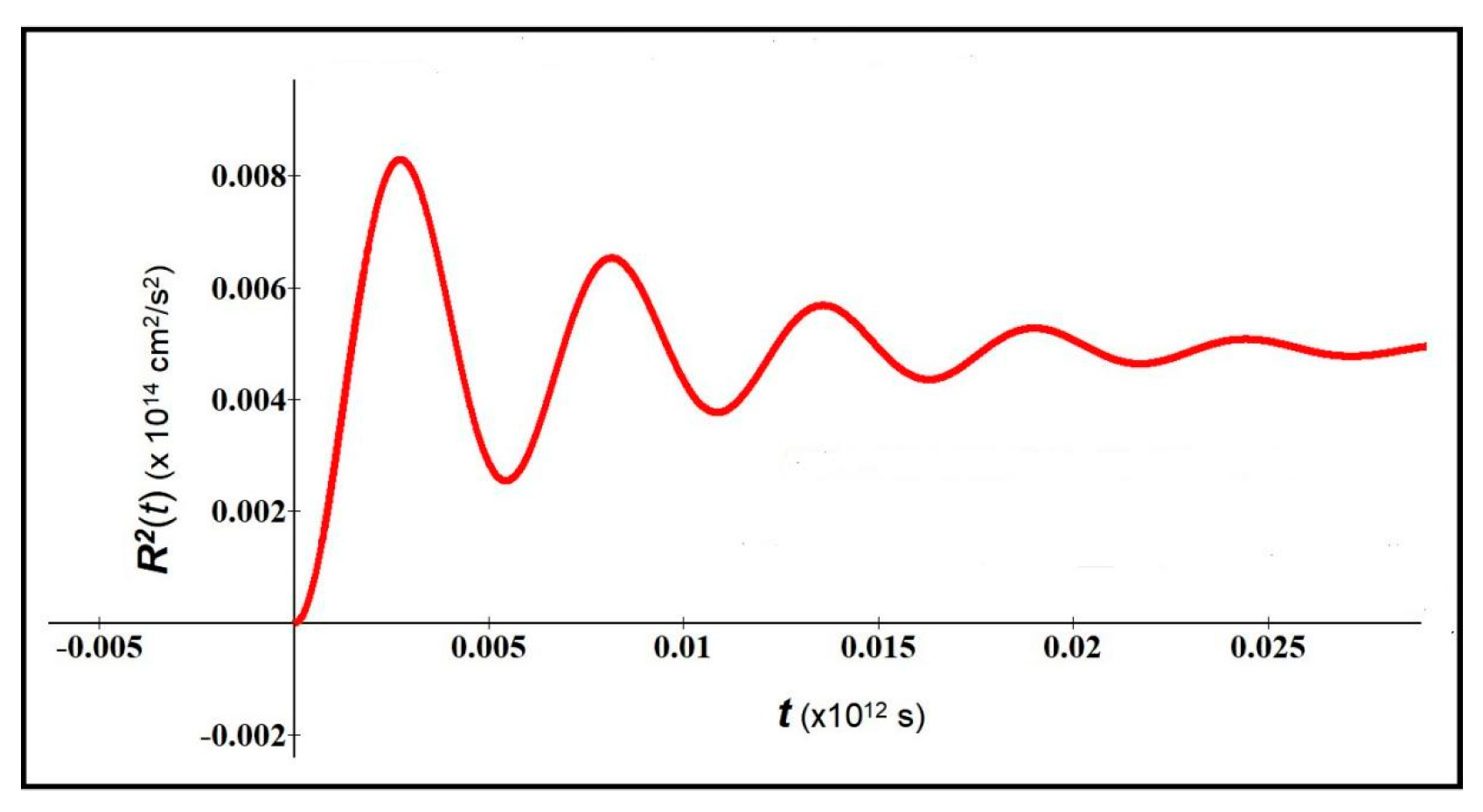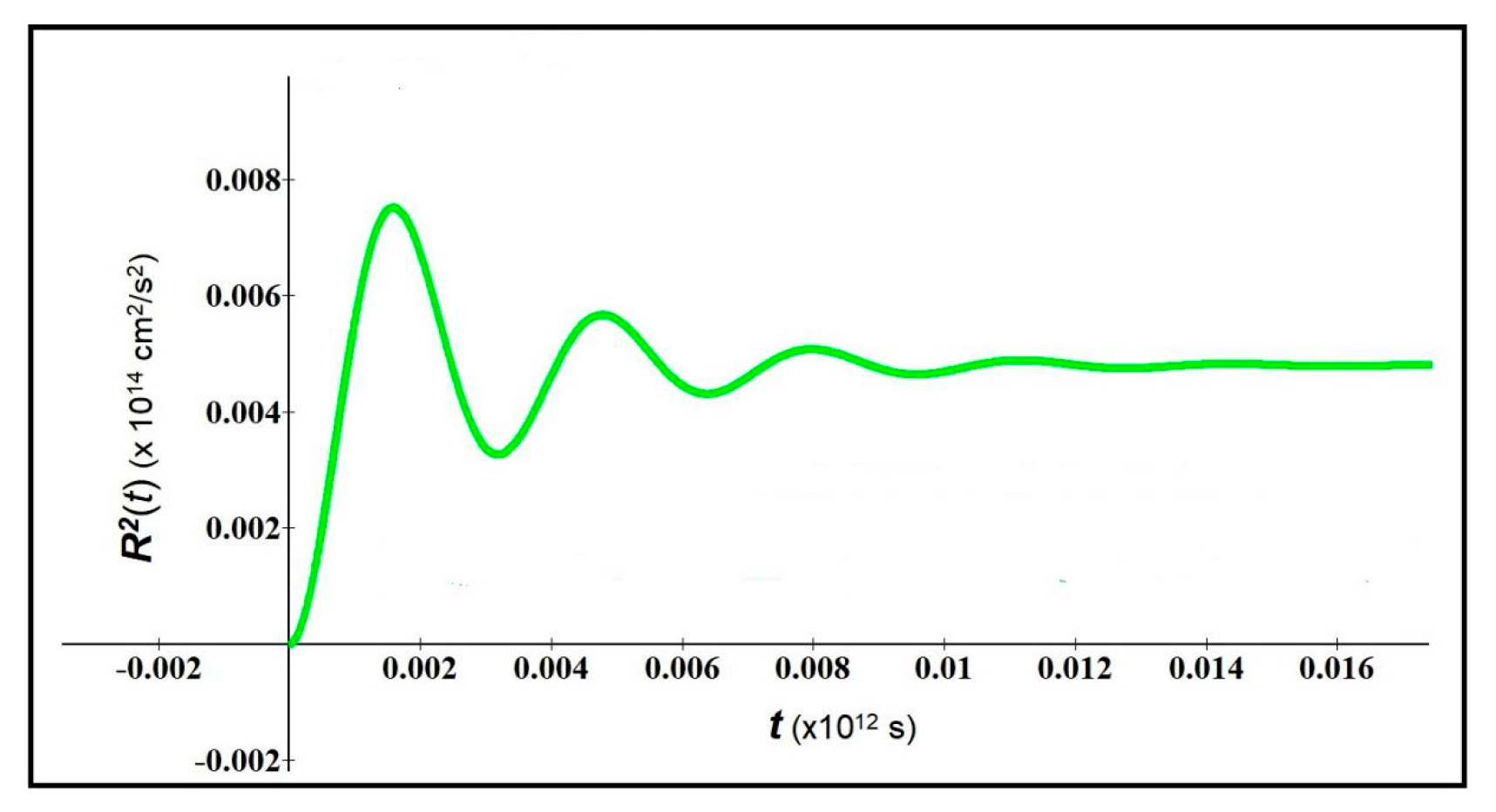Symmetry and the Nanoscale: Advances in Analytical Modeling in the Perspective of Holistic Unification
Abstract
1. Introduction
2. A Recently Appeared Drude–Lorentz-Type Model
3. Analytical Expression of the Mean Square Deviation of Position in the Quantum-Relativistic Case
- -
- -
- , energies of the excited and the ground states, respectively;
- -
- inverse of the decay time of every mode;
- -
- N density of carriers.
4. Results and Applications
- (1)
- Photon-Induced Near-Field Electron Microscopy: this inspection technique connects the spatial resolution at the nanoscale of the electron microscopy with the femto-second temporal resolution of extreme fast light impulses; it can be used to check very fast occurrences present at very small length scales. A way for raising the electron-light interactions in very short intervals consists of enlarging the light field through two synchronized femto-second light impulses. Variations of the time delay among the exciting light impulses and the electronic imaging ones allow one to obtain snapshots of the evanescent field as it evolves on femto-second intervals. The application of still shorter pulses can allow us to keep trace of the extreme fast processes happening in photonic and plasmonic devices [28,29].
- (2)
- Graphene based plasmonics: the non-linear optical properties of a plasma expected in the relativistic movement of electrons subjected to a high laser field are of central significance in the present research. Recently herein showed fast progress in the sector of graphene plasmonics, especially considering graphene’s special global properties. The application of graphene plasmonics will give stimulating results in the little-exploited terahertz to mid-infrared regime.
5. Conclusions
Funding
Data Availability Statement
Acknowledgments
Conflicts of Interest
References
- Di Sia, P. Industry 4.0 Revolution: Introduction. In Handbook of Smart Materials, Technologies, and Devices; Hussain, C.M., Di Sia, P., Eds.; Springer Nature: Cham, Switzerland, 2021; Chapter 1; pp. 1–20. [Google Scholar] [CrossRef]
- Ge, W.; Chen, F.; Gao, J.; Gao, S.; Huang, J.; Liu, X.; Ren, Y.; Sun, Q.; Wang, L.; Wang, W.; et al. Analytical multi-scale method for multi-phase complex systems in process engineering—Bridging reductionism and holism. Chem. Eng. Sci. 2007, 62, 3346–3377. [Google Scholar] [CrossRef]
- Ellis, G.F.R.; Di Sia, P. Complexity Theory in Biology and Technology: Broken Symmetries and Emergence. Symmetry, 2023; submitted. [Google Scholar]
- Ellis, G.F.R. Emergence in Solid State Physics and Biology. Found. Phys. 2020, 50, 1098–1139. [Google Scholar] [CrossRef]
- Di Sia, P. On risks and benefits of nanotechnology: The case of medical applications. In Handbook of Functionalized Nanomaterials: Environmental Health and Safety; Hussain, C.M., Kumar, V., Eds.; Elsevier Publishing: Amsterdam, The Netherlands, 2021; Chapter 9; pp. 235–250. Available online: https://www.sciencedirect.com/book/9780128224151/handbook-of-functionalized-nanomaterials (accessed on 10 August 2023).
- Healey, R. Holism in Quantum Mechanics. In Compendium of Quantum Physics; Greenberger, D., Hentschel, K., Weinert, F., Eds.; Springer: Berlin/Heidelberg, Germany, 2009; pp. 295–298. Available online: https://link.springer.com/chapter/10.1007/978-3-540-70626-7_91 (accessed on 10 August 2023).
- Di Sia, P. Mathematics and Physics for Nanotechnology—Technical Tools and Modelling; Di Sia, P., Ed.; Pan Stanford Publishing: Singapore, 2019; Available online: https://www.taylorfrancis.com/books/mono/10.1201/9780429027758/mathematics-physics-nanotechnology-paolo-di-sia (accessed on 10 August 2023).
- Di Sia, P. Modelling at Nanoscale. In Plasmonics—Principles and Applications; Kim, K.Y., Ed.; IntechOpen: London, UK, 2012; Chapter 1; pp. 3–22. [Google Scholar] [CrossRef]
- Ma, X.; Ma, Y.; Cunha, P.; Liu, Q.; Kudtarkar, K.; Xu, D.; Wang, J.; Chen, Y.; Wong, Z.J.; Liu, M.; et al. Strategical Deep Learning for Photonic Bound States in the Continuum. Laser Photonics Rev. 2022, 16, 2100658. [Google Scholar] [CrossRef]
- Liang, B.; Xu, D.; Yu, N.; Xu, Y.; Ma, X.; Liu, Q.; Asif, M.S.; Yan, R.; Liu, M. Physics-Guided Neural-Network-Based Inverse Design of a Photonic-Plasmonic Nanodevice for Superfocusing. ACS Appl. Mater. Interfaces 2022, 14, 27397–27404. [Google Scholar] [CrossRef] [PubMed]
- Di Sia, P. An Analytical Transport Model for Nanomaterial. J. Comput. Theor. Nanosci. 2011, 8, 84–89. [Google Scholar] [CrossRef]
- Di Sia, P. An Analytical Transport Model for Nanomaterials: The Quantum Version. J. Comput. Theor. Nanosci. 2012, 9, 31–34. [Google Scholar] [CrossRef]
- Di Sia, P. Relativistic nano-transport and artificial neural networks: Details by a new analytical model. Int. J. Artif. Intell. Mechatron. 2014, 3, 96–100. Available online: https://www.ijaim.org/vol-issues.html?view=publication&task=show&id=95 (accessed on 10 August 2023).
- Beard, M.C.; Turner, G.M.; Schmuttenmaer, C.A. Terahertz spectroscopy. J. Phys. Chem. B 2002, 106, 7146–7159. [Google Scholar] [CrossRef]
- Hassan, M.T. Attomicroscopy: From femtosecond to attosecond electron microscopy. J. Phys. B At. Mol. Opt. Phys. 2018, 51, 032005. [Google Scholar] [CrossRef]
- Di Sia, P. A new theoretical Model for the dynamical Analysis of Nano-Bio-Structures. Adv. Nano Res. 2013, 1, 29–34. [Google Scholar] [CrossRef]
- Di Sia, P.; Dallacasa, V. Anomalous charge transport: A new “time domain” generalization of the Drude model. Plasmonics 2011, 6, 99–104. [Google Scholar] [CrossRef]
- Rudin, W. Real and Complex Analysis, 3rd ed.; McGraw-Hill Higher Education: Singapore, 1987. [Google Scholar]
- Ventura, P.J.; Costa, L.C.; Carmo, M.C.; Roman, H.E.; Pavesi, L. AC Conductivity of Porous Silicon from Monte Carlo Simulations. J. Porous Mater. 2000, 7, 107–110. [Google Scholar] [CrossRef]
- Di Sia, P. Quantum-Relativistic Velocities in Nano-Transport. Appl. Surf. Sci. 2018, 446, 187–190. [Google Scholar] [CrossRef]
- Schmuttenmaer, C.A. Using Terahertz Spectroscopy to Study Nanomaterials. Terahertz Sci. Technol. 2008, 1, 1–8. [Google Scholar] [CrossRef]
- Baxter, J.B.; Schmuttenmaer, C.A. Conductivity of ZnO Nanowires, Nanoparticles, and Thin Films Using Time-Resolved Terahertz Spectroscopy. J. Phys. Chem. B 2006, 110, 25229–25239. [Google Scholar] [CrossRef]
- Baxter, J.B.; Schmuttenmaer, C.A. Carrier Dynamics in Bulk ZnO. I. Intrinsic Conductivity Measured by Terahertz Time Domain Spectroscopy. Phys. Rev. B 2009, 80, 235206. [Google Scholar] [CrossRef]
- Dexheimer, S.L. (Ed.) Terahertz Spectroscopy—Principles and Applications, 1st ed.; CRC Press Taylor & Francis Group LLC: Boca Raton, FL, USA, 2008. [Google Scholar]
- El Shabrawy, K.; Maharatna, K.; Bagnall, D.; Al-Hashimi, B.M. Modeling SWCNT Bandgap and Effective Mass Variation Using a Monte Carlo Approach. IEEE Trans. Nanotechnol. 2010, 9, 184–193. [Google Scholar] [CrossRef]
- Di Sia, P. About the Influence of Temperature in Single-Walled Carbon Nanotubes: Details from a new Drude-Lorentz-like Model. Appl. Surf. Sci. 2013, 275, 384–388. [Google Scholar] [CrossRef]
- Borondics, F.; Kamarás, K.; Nikolou, M.; Tanner, D.B.; Chen, Z.H.; Rinzler, A.G. Charge dynamics in transparent single-walled carbon nanotube films from optical transmission measurements. Phys. Rev. B 2006, 74, 045431–045436. [Google Scholar] [CrossRef]
- Park, S.T.; Lin, M.; Zewail, A.H. Photon-induced near-field electron microscopy (PINEM): Theoretical and experimental. New J. Phys. 2010, 12, 123028. [Google Scholar] [CrossRef]
- Park, S.T.; Zewail, A.H. Relativistic Effects in Photon-Induced Near Field Electron Microscopy. J. Phys. Chem. A 2012, 116, 11128–11133. [Google Scholar] [CrossRef]
- Grigorenko, A.N.; Polini, M.; Novoselov, K.S. Graphene plasmonics. Nat. Photonics 2012, 6, 749–758. [Google Scholar] [CrossRef]
- Koppens, F.H.L.; Chang, D.E.; García de Abajo, F.J. Graphene Plasmonics: A Platform for Strong Light-Matter Interactions. Nano Lett. 2011, 11, 3370–3377. [Google Scholar] [CrossRef] [PubMed]
- Huang, S.; Song, C.; Zhang, G.; Yan, H. Graphene plasmonics: Physics and potential applications. Nanophotonics 2017, 6, 1191–1204. [Google Scholar] [CrossRef]
- Kuzmin, D.A.; Bychkov, I.V.; Shavrov, V.G.; Temnov, V.V. Plasmonics of magnetic and topological graphene-based nanostructures. arXiv 2017, arXiv:1711.10777v1. [Google Scholar] [CrossRef]
- Kovalev, S.; Green, B.; Golz, T.; Maehrlein, S.; Stojanovic, N.; Fisher, A.S.; Kampfrath, T.; Gensch, M. Probing ultra-fast processes with high dynamic range at 4th-generation light sources: Arrival time and intensity binning at unprecedented repetition rates. Struct. Dyn. 2017, 4, 024301. [Google Scholar] [CrossRef]
- Bennett, K.; Rouxel, J.R.; Mukamel, S. Linear and nonlinear frequency- and time-domain spectroscopy with multiple frequency combs. J. Chem. Phys. 2017, 147, 094304. [Google Scholar] [CrossRef] [PubMed]
- Hafez, H.A.; Chai, X.; Sekine, Y.; Takamura, M.; Oguri, K.; Al-Naib, I.; Dignam, M.M.; Hibino, H.; Ozaki, T. Effects of environmental conditions on the ultrafast carrier dynamics in graphene revealed by terahertz spectroscopy. Phys. Rev. B 2017, 95, 165428. [Google Scholar] [CrossRef]
- Bohm, D. Wholeness and the Implicate Order, 1st ed.; Routledge: London, UK; New York, NY, USA, 2002. [Google Scholar]
- Bohm, D.; Hiley, B.J. The Undivided Universe: An Ontological Interpretation of Quantum Theory, 1st ed.; Routledge: London, UK; New York, NY, USA, 1995. [Google Scholar]
- Pribram, K.H. Languages of the Brain: Experimental Paradoxes and Principles in Neuropsychology, 5th ed.; Brandon House: New York, NY, USA, 1971. [Google Scholar]
- Di Sia, P. The Primordial Dynamic Space (Introduction 1). OSF Preprint Services. 2022. Available online: https://osf.io/qd4fb/ (accessed on 10 August 2023).
- Capra, F. The Tao of Physics: An Exploration of the Parallels Between Modern Physics and Eastern Mysticism, updated ed.; Shambhala Pubns: Boulder, CO, USA, 2010. [Google Scholar]
- Heisenberg, W. Physics and Beyond; Allen & Unwin: Sydney, NSW, Australia, 1971. [Google Scholar]
- Holism and Nonseparability in Physics. Available online: https://plato.stanford.edu/entries/physics-holism/ (accessed on 10 August 2023).







| v (cm/s) | β2 | 1/ρ | γ |
|---|---|---|---|
| 107 | 0.11 × 10−6 | 0.998 | 1.001 |
| 1010 | 0.11 | 0.888 | 1.061 |
| 2.5 × 1010 | 0.69 | 0.31 | 1.796 |
| States | ωi (×10−12 Hz) | τi (×1012 Hz) | fi |
|---|---|---|---|
| 1 | 6.59 | 0.0042 | 0.312 |
| 2 | 1166.01 | 0.0037 | 0.176 |
| 3 | 2000.05 | 0.0014 | 0.512 |
Disclaimer/Publisher’s Note: The statements, opinions and data contained in all publications are solely those of the individual author(s) and contributor(s) and not of MDPI and/or the editor(s). MDPI and/or the editor(s) disclaim responsibility for any injury to people or property resulting from any ideas, methods, instructions or products referred to in the content. |
© 2023 by the author. Licensee MDPI, Basel, Switzerland. This article is an open access article distributed under the terms and conditions of the Creative Commons Attribution (CC BY) license (https://creativecommons.org/licenses/by/4.0/).
Share and Cite
Di Sia, P. Symmetry and the Nanoscale: Advances in Analytical Modeling in the Perspective of Holistic Unification. Symmetry 2023, 15, 1611. https://doi.org/10.3390/sym15081611
Di Sia P. Symmetry and the Nanoscale: Advances in Analytical Modeling in the Perspective of Holistic Unification. Symmetry. 2023; 15(8):1611. https://doi.org/10.3390/sym15081611
Chicago/Turabian StyleDi Sia, Paolo. 2023. "Symmetry and the Nanoscale: Advances in Analytical Modeling in the Perspective of Holistic Unification" Symmetry 15, no. 8: 1611. https://doi.org/10.3390/sym15081611
APA StyleDi Sia, P. (2023). Symmetry and the Nanoscale: Advances in Analytical Modeling in the Perspective of Holistic Unification. Symmetry, 15(8), 1611. https://doi.org/10.3390/sym15081611






